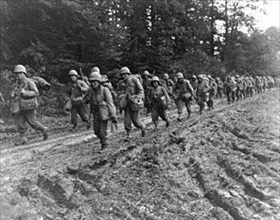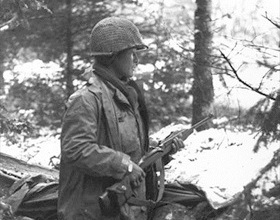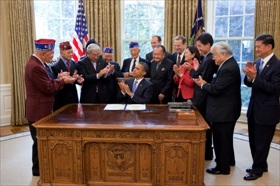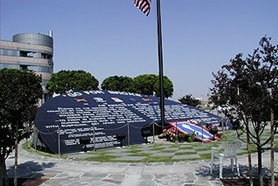GERMANS FLEE NORMANDY, ENGAGE U.S. 442ND RCT IN VOSGES MOUNTAINS
Berlin, Germany • August 16, 1944
On this date in 1944, two-and-one-half months after the Allies had landed on the Normandy coast of German-occupied Northwestern France (Operation Overlord) and one day after thousands of servicemen from the U.S. Seventh and French First armies had landed by air and sea on the French Riviera in the southeast corner of France (Operation Dragoon), Adolf Hitler reversed himself and ordered his troops out of Normandy to a new defense line in Northeastern France on the Somme and Marne rivers. The Franco-American landings on the French Riviera (known in France as the Côte d’Azur, or “Azure Coast”), augmented by elite British and Canadian units, opened a second French front in the presence of British Prime Minister Winston Churchill aboard a British destroyer. The new front, following on the heels of the gale-induced lost of 1 of 2 artificial Mulberry harbors off the Normandy invasion coast and the damage to the great port of Cherbourg on the nearby Cotentin Peninsula by German demolition, provided the Western Allies with additional and sorely needed port facilities at Marseille and Toulon, the former home of the French Marine Nationale.
At his forward headquarters Wolfsschanze (Wolf’s Lair) in Rastenburg, East Prussia, Hitler stared at his maps table as gloomy news of a second French front in the West began to sink in. To his east the Soviet Army was advancing remorselessly in Belorussia (Belarus) and Western Poland toward the Nazi capital, Berlin. After their Normandy breakout, Allied infantry and tanks were sprinting eastward toward Paris, the French capital. Anglo-American bombers were pulverizing German cities, industrial centers, oil installations, and military targets day and night in their Combined Bomber Offensive. And now this new, even larger invasion force that was sweeping into the south of France. A gloomy Fuehrer looked up from his maps, muttering to senior Wehrmacht officers: “This has been the worst day of my life.” (On November 20, 1944, with the Red Army just 9 miles/14½ km away, Hitler quit Wolf’s Lair for good.)
Over the next 2 months the Allied advance northward from the Mediterranean coast through the French Rhône Valley pushed the Germans toward their own border. The advance came to a halt at the foothills of the Vosges Mountains of Alsace-Lorraine in Eastern France due to lack of fuel. There Lt. Gen. Alexander Patch’s U.S. Seventh Army linked up with Gen. George S. Patton’s Third Army moving east from Normandy, to become part of Gen. Dwight D. Eisenhower’s European Theater command. In their Vosges Mountain fortress, the toughest terrain on the Western Front, retreating Wehrmacht soldiers were ordered by Hitler to stand and fight.
The Vosges Mountains campaign is notable for the rescue of “The Lost Battalion,” the 1st Battalion, 141st Regiment, which was surrounded by German forces on October 24, 1944. In 5 days of battle, from October 26 to October 30, the legendary 442nd Regimental Combat Team, a unit composed of mostly second-generation Japanese Americans (Nisei), managed to break through German infantry and artillery defenses, charging up steep, slippery slopes, firing from the hip, lobbing hand grenades into dugouts, many of them shouting “Make! Make! Make!”—“death” in Hawaiian. Enemy survivors fled in disarray. More than 200 of the “lost” soldiers were rescued while their rescuers suffered over 800 casualties. (The 442nd is considered to be the most-decorated unit of its size in the history of the U.S. Army. Its record-setting decoration count earned it the nickname “Purple Heart Battalion.”)
The Allied victory in the monthlong Vosges slugfest freed Patton to focus on driving east to the Rhine River and striking into the German heartland. Hitler, however, had one last ace up his sleeve, which he played in the Ardennes Forest of Belgium and Luxembourg, site of the Battle of the Bulge in late 1944/early 1945. It was Germany’s last-ditch effort to stop the Allied advance into Germany proper, and it failed.
Japanese American Contributions to Winning the War in Europe
 |  |
Left: On their way to liberate Bruyères, France, from German occupation, riflemen of the 2nd Battalion, 442nd Regimental Combat Team slog their way along a muddy logging road in the Chambois sector of the Vosges Mountains, October 14, 1944. The newly formed Nisei 442nd left the States on May 1, 1944, and landed at Anzio, Italy, on May 28. In August the unit took part in Operation Dragoon, the invasion of Southern France, and traveled 500 miles/805 km up the Rhône Valley, by walking and by rail, until October 13, when it reached the Vosges Mountains. On October 23 the unit, whose motto was “Go for Broke” (craps game lingo for “shoot the works”) was ordered to rescue the “lost battalion” of 141st “Alamo Regiment” of the 36th (Texas “T-Patchers”) Infantry Division. It cost the 442nd 800 casualties to rescue the remaining 211 men (down from 275) trapped 7 days behind enemy lines.
![]()
Right: From his snowy foxhole near Saint-Dié, France, Sgt. Goichi Richard Suehiro, 23‑year-old machine-gun squad leader with Company F, 2nd Battalion, 442nd Regimental Combat Team, looks through cold mist for German movements in a valley 200 yards/183 m away, November 13, 1944. The 442nd was the most decorated unit for its size and length of service in the history of American warfare. Its members—in total, about 14,000 men—received 18,143 awards, including 9,486 Purple Hearts for a composite Purple Heart rate of a staggering 68 percent. The unit was awarded an unprecedented eight Presidential Unit Citations. Twenty-one of its members were awarded Medals of Honor, including future U.S. senator Daniel Inouye (1924–2012) of Hawaii. The men of the 442nd Regimental Combat Team accounted for just over 40 percent of the Japanese Americans who served in the U.S. military in World War II. Many who served had family members back home incarcerated in U.S. government internment camps for the duration of the war. In 2012 France made all surviving members of the 442nd chevaliers (knights) of the French Légion d’Honneur, the highest French order of merit for military and civil distinction, for their actions contributing to the liberation of France and their heroic rescue of the Lost Battalion.
 |  |
Left: On July 15, 1946, when President Harry S. Truman welcomed the return home of the 442nd Regimental Combat Team (Nisei recruits raised on Hawaii and the mainland) and its “big brother” component, the 100th Infantry Battalion (Nisei soldiers from Hawaii who had enlisted or been drafted before the war began), he told the men: “You fought not only the enemy, but you fought prejudice—and you have won.” On October 5, 2010, President Barack Obama (pictured here) signed a bill granting the Congressional Gold Medal collectively to the 442nd Regimental Combat Team and the 100th Infantry Battalion (merged June 1944) in recognition of their dedicated service during World War II. The award was also extended to the 6,000 Japanese Americans who served in the Military Intelligence Service during the war.
![]()
Right: The Go for Broke Monument in Little Tokyo, Los Angeles, California, commemorates the 33,000 Japanese Americans who served in the U.S. military during World War II—the famed 100th Infantry Battalion and 442nd Regimental Combat Team, as well as lesser-known Nisei units: the Military Intelligence Service mentioned above, the 522nd Field Artillery Battalion, the 232nd Combat Engineer Company, and the 1399th Engineering Construction Battalion. “Go for Broke!” was the unit motto of the 100th Battalion and was adopted by the 442nd RCT. It has since been adopted as a motto for all the Japanese American units formed during World War II.
The 442nd Regimental Combat Team and the Rescue of “The Lost Battalion”
![]()

 History buffs, there is good news! The Daily Chronicles of World War II is now available as an ebook for $4.99 on Amazon.com. Containing a year’s worth of dated entries from this website, the ebook brings the story of this tumultuous era to life in a compelling, authoritative, and succinct manner. Featuring inventive navigation aids, the ebook enables readers to instantly move forward or backward by month and date to different dated entries. Simple and elegant! Click
History buffs, there is good news! The Daily Chronicles of World War II is now available as an ebook for $4.99 on Amazon.com. Containing a year’s worth of dated entries from this website, the ebook brings the story of this tumultuous era to life in a compelling, authoritative, and succinct manner. Featuring inventive navigation aids, the ebook enables readers to instantly move forward or backward by month and date to different dated entries. Simple and elegant! Click 











